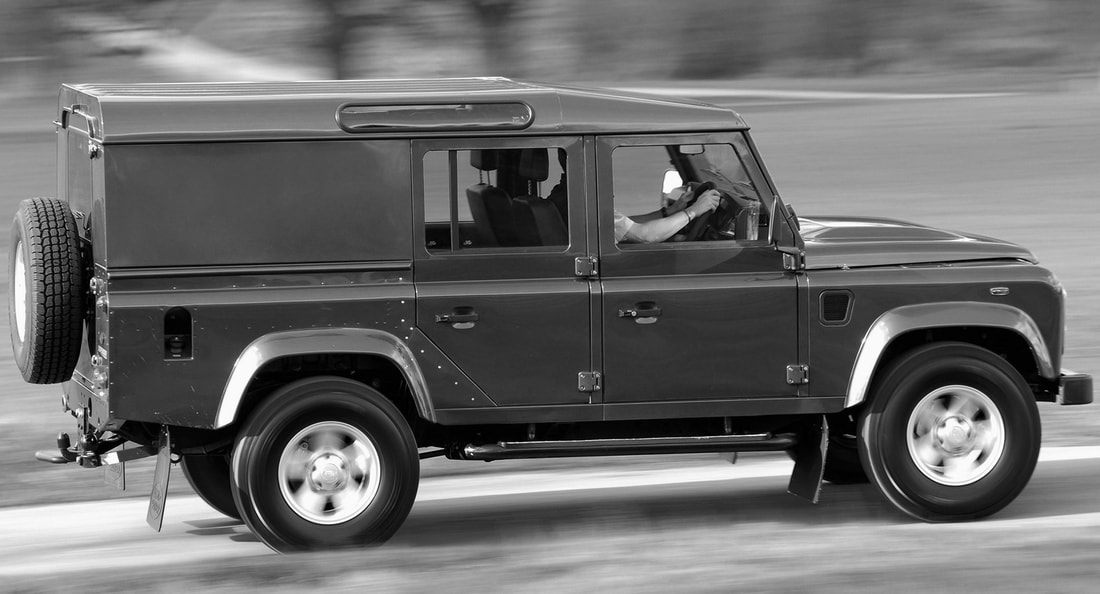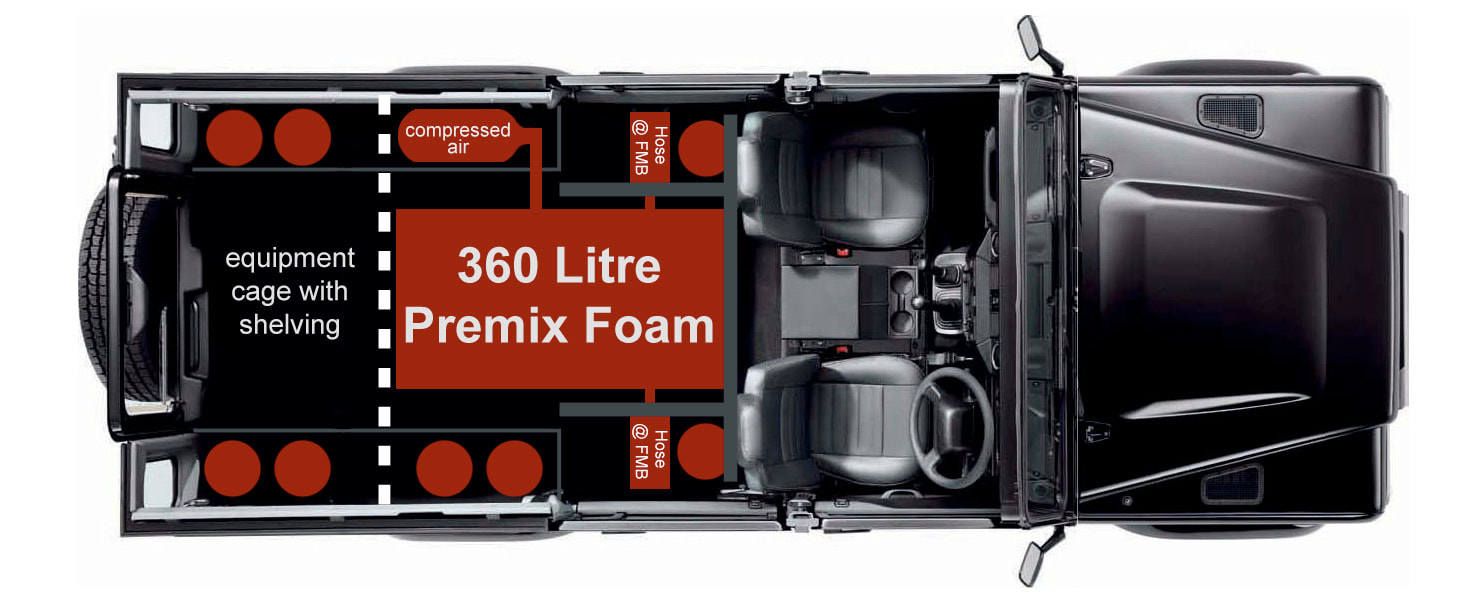Concept: Defender CrT
In January 2016, Land Rover ended production of the Defender, resulting in this particular project becoming an impossibility. That said, the idea to produce a low-cost fire engine was always going to be a concept or pipe dream.
It was born out of a concern that this country’s Air Cadets were being denied appropriate fire and rescue equipment at some of its powered Grob G109 Vigilant glider sites. At the time, some airfields were only equipped with a single 90 litre fire extinguisher – towed behind a Land Rover. My idea was to create an affordable upgrade. The problem was not the design, but the bureaucratic nightmare of making things happen within the MoD. The idea was too simple and too affordable to be taken seriously.
It was born out of a concern that this country’s Air Cadets were being denied appropriate fire and rescue equipment at some of its powered Grob G109 Vigilant glider sites. At the time, some airfields were only equipped with a single 90 litre fire extinguisher – towed behind a Land Rover. My idea was to create an affordable upgrade. The problem was not the design, but the bureaucratic nightmare of making things happen within the MoD. The idea was too simple and too affordable to be taken seriously.
At the time, the RAF’s Air Cadet Organisation (ACO) operated a number of Volunteer Gliding Squadrons (VGS), operating Viking TX1 (conventional) and Vigilant T1 (motor) gliders for both the Combined Cadet Force (CCF) and the Air Training Corps (ATC). The powered Vigilant gliders were uniquely categorised within the MoD as requiring “1M 1 Special” RFFS (Rescue and Fire Fighting Service) provision. This was nominally a single trailer-mounted 90 litre fire extinguisher – towed behind a Land Rover. Approximately half of these motor gliders VGS units maintained this level of RFFS provision.
Some VGS units were attached to populated military camps (including Cosford, Halton and Topcliffe), which themselves were only equipped with a single domestic fire tender. Some VGS units were based at major airfields, whose RFFS are more than up to the job, but at the time of writing this proposal, there were around eight isolated sites which would have benefited from this proposed Defender CrT:
612 VGS ** Dalton Barracks (disbanded August 2016)
613 VGS ** RAF Halton (disbandment announced March 2016)
616 VGS ** RAF Henlow (disbandment announced March 2016)
632 VGS ** RAF Turnhill (now flying conventional gliders)
633 VGS ** RAF Cosford (disbandment announced March 2016)
637 VGS ** RAF Little Rissington (now flying conventional gliders)
644 VGS ** RAF Syerston (now flying conventional gliders)
645 VGS ** RAF Topcliffe (now flying conventional gliders)
This was my proposal and design brief for an affordable, yet capable aerodrome crash tender, designed around the Land Rover Defender 110 Utility Station Wagon. The vehicle was only intended for use on minor aerodromes, both military and civilian; licensed and unlicensed. The vehicle was named the CrT, which is the accepted abbreviation for Crash Tender.
Some VGS units were attached to populated military camps (including Cosford, Halton and Topcliffe), which themselves were only equipped with a single domestic fire tender. Some VGS units were based at major airfields, whose RFFS are more than up to the job, but at the time of writing this proposal, there were around eight isolated sites which would have benefited from this proposed Defender CrT:
612 VGS ** Dalton Barracks (disbanded August 2016)
613 VGS ** RAF Halton (disbandment announced March 2016)
616 VGS ** RAF Henlow (disbandment announced March 2016)
632 VGS ** RAF Turnhill (now flying conventional gliders)
633 VGS ** RAF Cosford (disbandment announced March 2016)
637 VGS ** RAF Little Rissington (now flying conventional gliders)
644 VGS ** RAF Syerston (now flying conventional gliders)
645 VGS ** RAF Topcliffe (now flying conventional gliders)
This was my proposal and design brief for an affordable, yet capable aerodrome crash tender, designed around the Land Rover Defender 110 Utility Station Wagon. The vehicle was only intended for use on minor aerodromes, both military and civilian; licensed and unlicensed. The vehicle was named the CrT, which is the accepted abbreviation for Crash Tender.
Most crash tenders are scratched-built or based on the chassis/cab of an existing vehicle, including the Land Rover Defender itself. This makes the acquisition of even the most basic of vehicle a financial burdan. This proposal used an existing vehicle that could have easily been adapted, without chopping up bodywork. The Defence CrT was designed to appeal to a wide range of potential customers. That said, I envisaged no more than eight vehicles being built, but this would still have offered valuable project management experience.
With a crew of two fire-fighters, the rear seating would have be removed – replaced with rescue and fire-fighting equipment, accessible through three of the vehicle’s five doors: thus no need for expensive or superfluous shutters. The interior would have been fitted out with an internal roll cage (located behind the crew seats) and an equipment cage (accessible through the rear door). The primary fire-fighting package would have been centrally located between this equipment cage and front seating. Access to foam-making-branches (FMBs) and hoses would have been via the two side passenger doors.
With a crew of two fire-fighters, the rear seating would have be removed – replaced with rescue and fire-fighting equipment, accessible through three of the vehicle’s five doors: thus no need for expensive or superfluous shutters. The interior would have been fitted out with an internal roll cage (located behind the crew seats) and an equipment cage (accessible through the rear door). The primary fire-fighting package would have been centrally located between this equipment cage and front seating. Access to foam-making-branches (FMBs) and hoses would have been via the two side passenger doors.
The primary fire-fighting package (CAFS or regular pre-mixed foam) would have weighed in the region of 600Kg, and contain 360 litres of water. In case of vehicular accident this weighty package would have required additional support to prevent it from being dislodged and causing injury to the occupants. The roll cage would have have consisted of a base plate attached to the bodywork/chassis – onto which the fire-fighting package would have been affixed, along with the roll bar itself and additional support members (straddling the primary water tank). The roll bar would have physically prevented the tank from moving forward in an accident, while providing additional attachment points for equipment. This vehicle would have also carried additional secondary media, namely 6 x 9kg Monnex and 2 x 5kg CO2 extinguishers. This secondary provision would have exceeded minimal civil and military requirements.
Attached to the inside-rear of the vehicle would have been the equipment cage – approximately 60cm in depth and spanning the full width and height of the vehicle. The equipment rack (fitted out with shelving and holding brackets) would have been enclosed by a welded grill – to prevent heavy objects being thrown forward if the vehicle stopped abruptly. This internal frame would have been installed in sections, each welded and powder coated for longevity. This sub-assembly would have been fitted after the primary fire-fighting package had been installed.
Attached to the inside-rear of the vehicle would have been the equipment cage – approximately 60cm in depth and spanning the full width and height of the vehicle. The equipment rack (fitted out with shelving and holding brackets) would have been enclosed by a welded grill – to prevent heavy objects being thrown forward if the vehicle stopped abruptly. This internal frame would have been installed in sections, each welded and powder coated for longevity. This sub-assembly would have been fitted after the primary fire-fighting package had been installed.
With the end of Land Rover Defender production this idea died. In May 2018 the Air Cadet Organisation retired all its powered gliders. There was one attempt to replace the aforementioned fire-fighting trailers, which ended in costly failure. A few years ago, a batch of new Bremach Fire Engines was commissioned and built at great expense. Now these very same vehicles quickly ended up on eBay. They served less that a week in military service. Officially, they were built to the wrong specification – carrying insufficient water. It reality, they were top heavy, and the first to be issued overturned within hours of being delivered. This costly design flaw cost millions.




